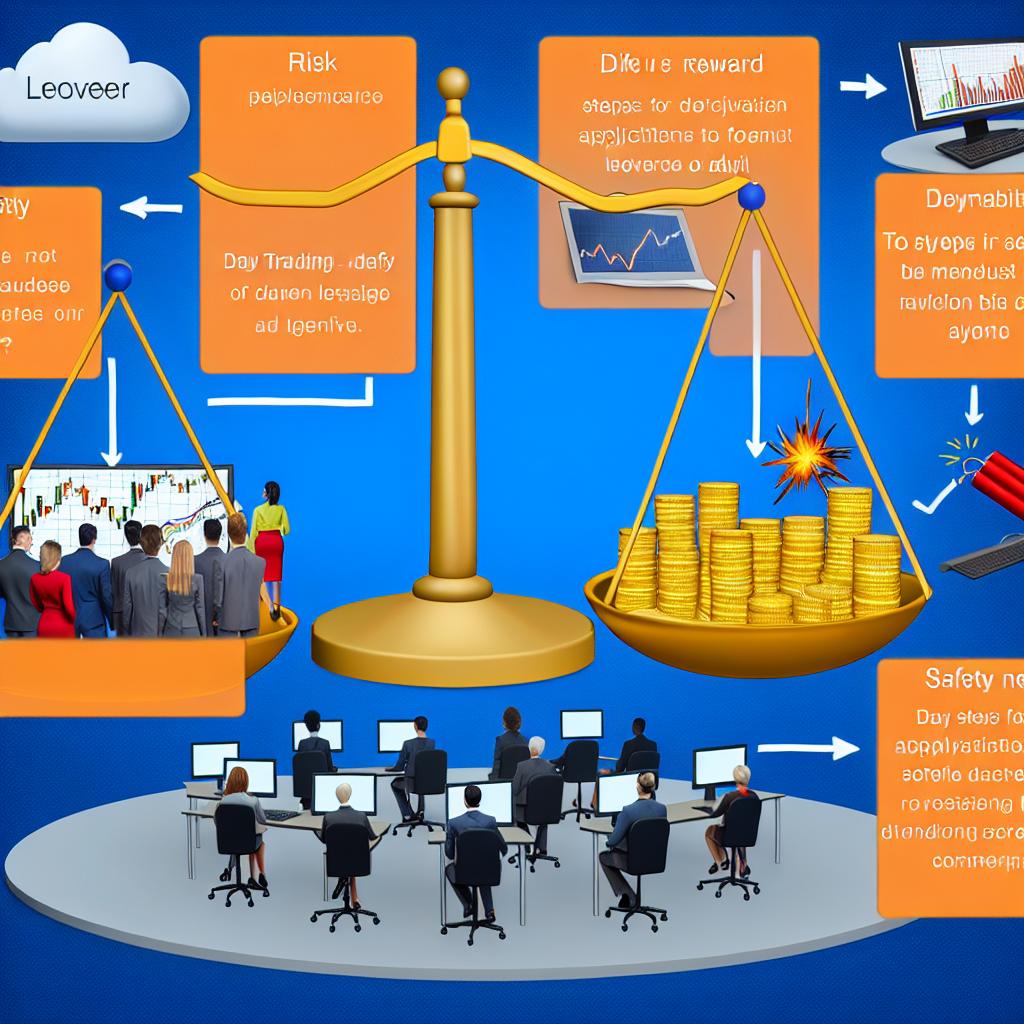Did you know that some institutional traders treat leverage like a double espresso—boosting their potential while risking a jittery crash? In this article, we delve into the intricacies of how institutional traders utilize leverage in day trading. We’ll cover the definition of leverage, its calculation, and common levels used by institutions. Additionally, we’ll discuss how leverage amplifies gains, the associated risks, and effective risk management strategies. Discover the regulations that govern leverage, the differences from retail trading, and the tools and strategies employed by institutions across various asset classes, especially in high-volatility markets. By understanding these key points, you’ll gain valuable insights into the powerful role of leverage in institutional trading, brought to you by DayTradingBusiness.
How Do Institutional Traders Use Leverage in Day Trading?
Institutional traders use leverage in day trading by borrowing large amounts of capital to amplify their market positions. They often access high leverage ratios through prime brokers or proprietary trading firms, sometimes 10:1 or higher. This allows them to control bigger positions with less capital, increasing potential profits and risks. They carefully manage leverage to maximize gains from small price movements while minimizing exposure to margin calls.
What Is Leverage and Why Do Institutions Use It?
Leverage in day trading is borrowing funds to control larger positions with a smaller amount of capital. Institutions use leverage to amplify their market exposure, aiming for bigger profits from small price moves. They leverage their significant capital to increase potential returns, but it also raises risks if the market moves against them. By using leverage, institutions can diversify their trades and maximize their trading strategies efficiently.
How Do Institutional Traders Calculate Leverage Ratios?
Institutional traders calculate leverage ratios by dividing the total amount of borrowed capital by their own equity in a trading position. For example, if they control $10 million in assets but only put up $1 million of their own money, the leverage ratio is 10:1. They use margin requirements set by exchanges or brokers to determine how much they can borrow, often aiming for higher ratios to maximize potential gains while managing risk.
What Are Common Leverage Levels for Institutional Day Trading?
Institutional traders typically use leverage levels ranging from 10:1 to 50:1 in day trading. They might go even higher with margin, depending on the asset and regulatory limits. This leverage amplifies both gains and losses, allowing institutions to control large positions with a relatively small amount of capital.
How Does Leverage Amplify Gains for Institutional Traders?
Institutional traders use leverage to control larger positions with less capital, amplifying both gains and losses. When a trade moves in their favor, leverage boosts their profit margins significantly. For example, with 10:1 leverage, a 1% market move can generate a 10% return on their invested capital. This ability to maximize upside potential allows institutions to capitalize on small price movements daily, increasing overall trading efficiency.
What Are the Risks of Using Leverage in Day Trading?

Using leverage in day trading amplifies both gains and losses, increasing the risk of significant financial loss if trades go against you. It can lead to margin calls, where you’re forced to deposit more funds or close positions at a loss. High leverage encourages riskier trades, potentially wiping out your account quickly. Market volatility can cause rapid margin depletion, leaving you exposed to sudden, large losses. Institutional traders mitigate these risks with risk management strategies, but individual traders often underestimate leverage’s danger.
How Do Institutions Manage Leverage-Related Risks?
Institutions manage leverage-related risks by setting strict position limits, using risk models, and implementing stop-loss orders. They constantly monitor market exposure, diversify assets, and employ hedging strategies like futures and options to protect against volatility. Risk management teams analyze leverage levels regularly to prevent over-leverage and minimize potential losses.
What Regulations Limit Leverage for Institutional Traders?
Regulations like the SEC’s Regulation T in the US limit leverage for institutional traders, typically capping margin at 2:1 for securities. The European Securities and Markets Authority (ESMA) restricts leverage for professional clients to 5:1 for stocks and lower for other assets. Basel III banking rules also limit leverage ratios for financial institutions. These rules are designed to prevent excessive risk-taking, reducing the leverage institutional traders can use in day trading.
How Do Institutional Traders Use Margin in Day Trading?
Institutional traders use margin in day trading by borrowing large sums to increase their buying power. They leverage capital to execute bigger positions, aiming for higher returns on short-term price movements. They often have access to favorable margin rates and can quickly adjust leverage levels based on market conditions. This allows them to capitalize on small price fluctuations with amplified exposure, while managing risk through sophisticated strategies.
How Is Leverage Different for Retail and Institutional Traders?

Retail traders typically use lower leverage, often 2:1 or 4:1, due to broker limits and risk management. Institutional traders access much higher leverage, sometimes 50:1 or more, thanks to their large capital and established relationships with prime brokers. They can borrow significant funds to amplify returns on day trades, but also face stricter regulations and risk controls. Retail leverage is more constrained and transparent, while institutional leverage is more complex and flexible, enabling larger position sizes and faster trading strategies.
What Tools Do Institutional Traders Use to Implement Leverage?
Institutional traders use margin accounts, derivatives like futures and options, and leveraged ETFs to implement leverage. They often employ sophisticated trading platforms with real-time data and risk management tools. They also rely on algorithmic trading systems to execute high-volume, leveraged positions efficiently.
How Do Leverage Strategies Vary Across Asset Classes?
Institutional traders use leverage differently across asset classes based on liquidity, volatility, and regulation. In equities, they often leverage through margin loans, typically 2-4x, to amplify small price moves. For commodities, leverage can be much higher via futures contracts, sometimes 10x or more, due to standardized contracts and lower margin requirements. In forex trading, leverage can reach 50x or higher, enabling rapid position scaling but increasing risk. Fixed income assets usually have lower leverage because of strict regulations and lower volatility. Overall, leverage strategies adapt to each asset's risk profile, liquidity, and regulatory environment.
How Do Institutional Traders Use Leverage in High-Volatility Markets?
Institutional traders use leverage in high-volatility markets to amplify their position sizes, allowing them to maximize gains from quick price movements. They typically borrow capital through margin accounts or derivatives like futures and options, scaling their trades based on their risk appetite and market conditions. During volatile periods, they adjust leverage levels carefully to avoid outsized losses while still capitalizing on rapid price swings. They also employ risk management tools like stop-loss orders and position sizing strategies to control leverage exposure in unpredictable markets.
Learn about How Do Institutional Traders Use Technical and Fundamental Analysis?
What Are the Benefits of Institutional Leverage in Day Trading?

Institutional traders use leverage in day trading to amplify their position sizes, allowing bigger bets with less capital. This increases potential profits on small price movements. Leverage also helps diversify risk across multiple trades quickly. It enables institutions to access higher liquidity and execute large orders efficiently. Overall, leverage boosts trading efficiency, profit opportunities, and market impact for institutional day traders.
How Do Institutions Monitor Leverage Levels During Trading?
Institutions monitor leverage levels during trading through real-time risk management systems that track margin requirements and position sizes. They set predefined limits on leverage ratios and use automated alerts to flag excessive borrowing. Risk officers review leverage exposure daily, adjusting positions to stay within acceptable levels. They also employ stress tests and scenario analysis to understand potential losses if leverage magnifies market moves. Overall, they use sophisticated software and strict protocols to ensure leverage remains controlled during trading.
How Does Leverage Impact Institutional Trading Performance?
Leverage amplifies gains and losses for institutional traders, increasing potential profits but also heightening risk. In day trading, institutions use leverage to control larger positions with less capital, aiming for bigger returns on small price movements. However, high leverage can lead to rapid losses if market moves against them, making risk management crucial. Proper use of leverage allows institutions to maximize trading efficiency, but overleveraging can quickly erode performance.
Learn about Institutional Trading Patterns and How They Impact Day Trading Opportunities
Conclusion about How Do Institutional Traders Use Leverage in Day Trading?
In conclusion, institutional traders leverage their expertise and access to sophisticated tools to enhance their trading strategies, amplifying potential gains while navigating significant risks. By understanding leverage ratios, managing risks effectively, and adhering to regulatory limits, these traders can optimize their performance across various asset classes. For those looking to deepen their understanding of leverage and its implications in day trading, DayTradingBusiness offers valuable insights and resources to guide your journey.
Learn about How Do Institutional Traders Manage Risk During Day Trading?
Sources:
- Institutional trading and asset pricing - ScienceDirect
- Institutional trading and satellite data - ScienceDirect
- Volume Weighted Average Price (VWAP) The Holy Grail for Day ...
- Trading behavior of institutional investors and CEO's market timing ...
- Can Day Trading Really Be Profitable?
- Institutional consensus after earnings announcements: Information ...